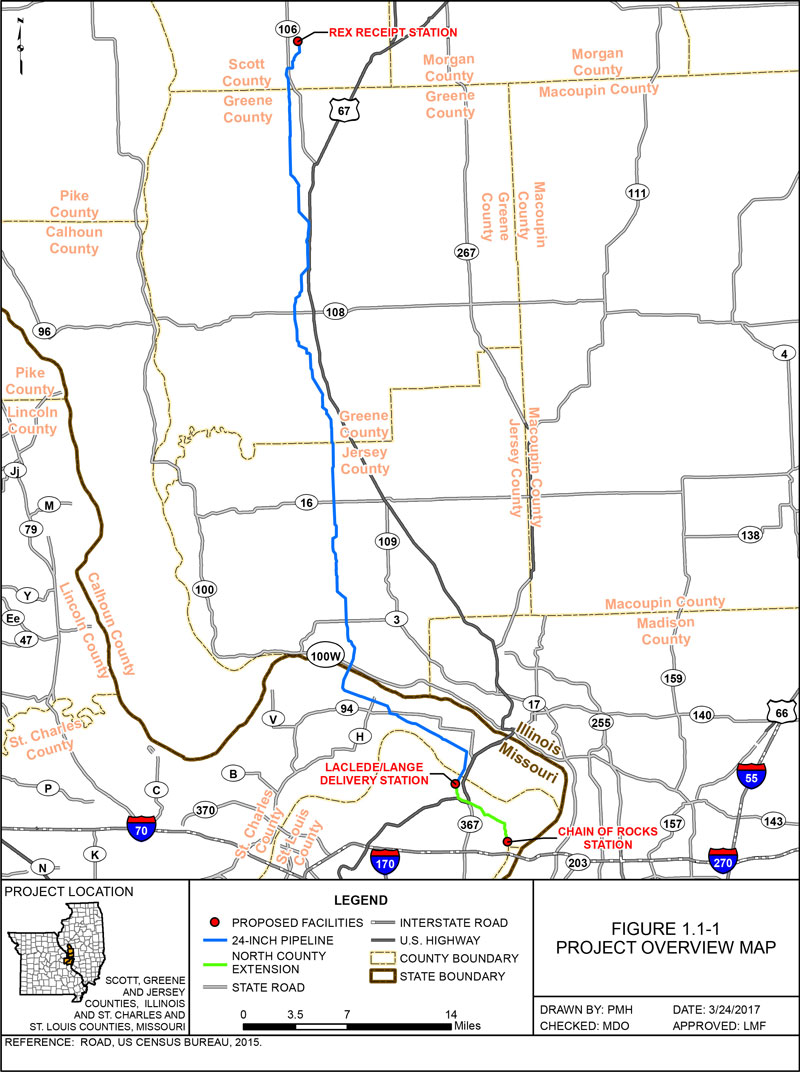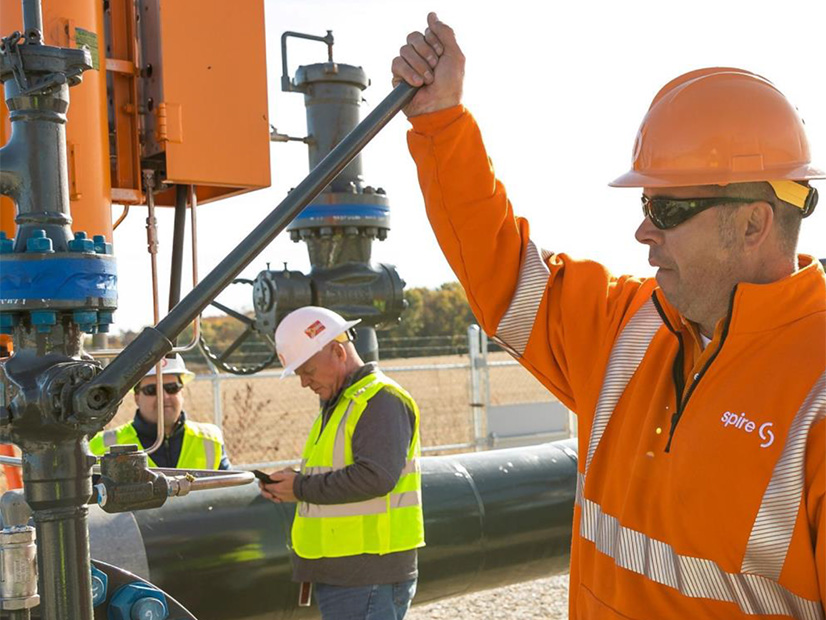The D.C. Circuit Court of Appeals ordered FERC Tuesday to vacate its decision permitting a 65-mile natural gas pipeline, saying the commission had failed to follow its own rules on evidence of a need for the facility (20-1016).
The court said FERC failed to balance the benefits and adverse impacts when it approved a certificate of public convenience and necessity for the Spire STL Pipeline on a 3-2 vote in August 2018 (CP17-40). It said the commission “made a superficial effort to remedy the obvious deficits of the certificate order” when it rejected rehearing requests in November 2019 — the same month the line went into commercial operation.
ClearView Energy Partners told clients that “closure of the asset may be more a question of when than if.”
Parent company Spire (NYSE:SR) did not respond to a request for comment. Shares in the company, which has gas utilities in Alabama, Mississippi and Missouri and storage operations on the Wyoming-Utah border, dropped by $3.49/share (-4.67%) after the ruling.
The ruling by Senior Circuit Judge Harry Edwards and Circuit Judges David Tatel and Patricia Millett was a victory for the Environmental Defense Fund (EDF), which filed the court challenge after failing to block the certificate in proceedings before FERC.
No Takers
Spire announced plans for the project in 2016 and held an “open season” in August of that year inviting gas shippers to sign preconstruction contracts. When it got no takers — the St. Louis area was already served by five existing pipelines — it signed an agreement with one of its affiliates, Laclede Gas Co. (now called Spire Missouri) for 87.5% of the line’s capacity. At the time, Spire Missouri obtained most of its natural gas from pipelines owned by Enable Mississippi River Transmission (Enable MRT), a unit of Enable Midstream (NYSE: ENBL).
In its January 2017 application to FERC, Spire conceded that the line was not being built to serve new load, but said it would provide other benefits, such as enhancing reliability and supply security by providing access to new sources of gas in the Rocky Mountains and Appalachian Basin and avoiding the New Madrid Seismic Zone. It also said it would eliminate the use of propane “peak-shaving” during periods of high demand. Spire later acknowledged that it had used propane peaking on only three days between 2013 and 2018.
The certificate application was protested by several stakeholders, including the Missouri Public Service Commission and Enable MRT, which said the project “ha[d] been shielded from a truly competitive market.”
Enable MRT also cited comments by Spire Missouri and Spire STL’s corporate parent that construction of the pipeline would increase shareholder earnings. It said the economic risks of the pipeline would be shifted onto Spire Missouri’s “captive ratepayers [for natural gas] and the ratepayers of pipelines that would experience decontracting due to” the new pipeline.
EDF told FERC there was a growing trend for utility holding companies making transactions committing retail utilities to new long-term capacity with their pipeline developer affiliates.
“The essence of this financing structure is to take a cost pass-through for a retail gas or electric distribution utility — a contract for natural gas transportation services — and pay those transportation fees to an affiliated pipeline developer entitled to accrue return on its investment from that same revenue,” EDF said. “Thus ratepayer costs which may not be justified by ratepayer demand are being converted into shareholder return.”
EDF asked the commission to “apply heightened scrutiny” to the application because of the affiliate relationship, saying “there is a gap … between state and federal regulatory oversight of affiliate precedent agreements, such as the one Spire STL has submitted in this proceeding to demonstrate market need.”
Balancing Benefits and Adverse Impacts
Under the Natural Gas Act, FERC can only issue a certificate if it finds that the new pipeline “is or will be required by the present or future public convenience and necessity.”

If FERC concludes there is a need, it then determines whether there will be adverse impacts on “existing customers of the pipeline proposing the project, existing pipelines in the market and their captive customers, or landowners and communities affected by the route of the new pipeline,” according to the commission’s Certificate Policy Statement, issued in 1999 and clarified in 2000. If it finds adverse impacts, the commission must balance the public benefits — such as meeting unserved demand, providing competitive alternatives or advancing clean air objectives — against the adverse effects.
The policy statement says FERC will “consider all relevant factors” to determine the need for a project and that the evidence “will usually include a market study. … Vague assertions of public benefits will not be sufficient.”
FERC’s decision acknowledged that the pipeline was not meant to serve new load and acknowledged the difference in the cost of gas delivered to Spire Missouri via the proposed pipeline versus current pipelines “was not materially significant.”
Nevertheless, the commission majority — Republicans Kevin J. McIntyre, Neil Chatterjee and Robert F. Powelson — rejected calls for a market study.
Commissioners Cheryl LaFleur (D) and Richard Glick (D) dissented on the order. Glick, now FERC chairman, noted that “[t]here are several potential business reasons why [Spire STL]’s corporate parent might prefer to own a pipeline rather than simply take service on it, such as the prospect of earning a 14% return on equity rather than paying rates to [Enable] MRT or another pipeline company.”
Spire told FERC in 2019 that the pipeline, which runs between Scott County, Ill. and St. Louis County, Mo., cost about $287 million, an increase of $67 million (30%) from its original estimate.
FERC’s ‘Ostrich-like Approach’
The court concluded that FERC’s decision “principally focused on the precedent agreement between Spire STL and Spire Missouri in finding that there was market need for the project. And the commission stated that it would not `second guess’ Spire Missouri’s purported `business decision’ in entering into the precedent agreement with Spire STL, even though the shipper and the pipeline were affiliates. … We find that the commission ignored record evidence of self-dealing and failed to seriously and thoroughly conduct the interest-balancing required by its own Certificate Policy Statement.”
The court said FERC took an “ostrich-like approach” by failing to consider “plausible evidence of self-dealing.”
“The challenges raised by EDF and others were more than enough to require the commission to ‘look behind’ the precedent agreement in determining whether there was market need. If it was not necessary for the commission to do so under these circumstances, it is hard to imagine a set of facts for which it would ever be required.
“… Instead of evaluating the legitimate claims that had been raised, the commission simply stated that it had “no reason to second guess the business decision of” Spire Missouri.
The court said EDF had standing to challenge the certificate because at least four of the group’s members owned land transected by the pipeline and had property rights taken through eminent domain. Spire initiated eminent domain proceedings against more than 100 entities involving more than 200 acres of privately owned land, according to Glick.
However, the court said a woman who lived half a mile from the pipeline and was not subject to eminent domain, had no standing to challenge FERC’s environmental assessment, which found that construction and operation of the pipeline would have no significant environmental impact.
Remedy
The court said vacating the certificate order was an appropriate remedy because of the “identified deficiencies in the commission’s orders.”
The commission’s ability “to rehabilitate its rationale … is not at all clear to us at this juncture,” the court said. “Furthermore, remanding without vacatur under these circumstances would give the commission incentive to allow ‘build[ing] first and conduct[ing] comprehensive reviews later.’”
The court’s mandate, which makes the ruling binding, will be issued seven days after the D.C. Circuit addresses any petition for rehearing or en banc review.
ClearView Energy Partners said it didn’t expect FERC to appeal the ruling given its current composition. Chatterjee’s term expires at the end of June, and he is expected to be replaced by a Democrat, giving the Democrats a 3-2 edge under Glick.
“Spire could seek rehearing from the panel on this decision or the full D.C. Circuit (en banc), but absent FERC support we would give it scant odds of success. At this time, we think that an appeal to the U.S. Supreme Court would be unlikely to succeed should Spire STL pursue one,” Clearview added. “The D.C. Circuit may not necessarily continue to withhold the mandate pending Supreme Court review. In our view, closure of the asset may be more a question of when than if.”
Pamela Quinlan, Glick’s chief of staff, tweeted that the decision “is a very big deal” and why Glick is pursuing the Notice of Inquiry that will look at how FERC assesses need, among other issues (PL18-1). (See Glick Hits ‘Refresh’ at 1st FERC Open Meeting.)



